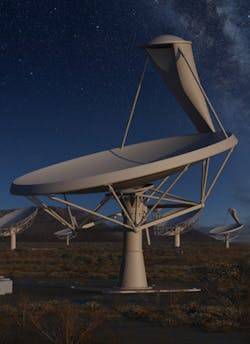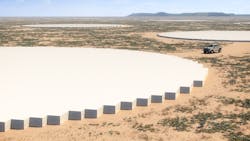RF “Black Art” Gets Behind the World’s Largest Radio Telescope
Calling the Square Kilometer Array (SKA) a “project,” doesn’t properly express the endeavor. More than 350 scientists and engineers--representing 18 nations and nearly 100 institutions--are currently on track to construct what will be the world’s largest radio telescope. Founded in 2011, the SKA organization has now designated several teams to work on separate parts of the telescope, which will eventually come together like pieces of a giant jigsaw puzzle. In the process, they will have to overcome many challenges.
Download this article in .PDF format
This file type includes high resolution graphics and schematics when applicapable.
With a total collecting area of approximately one square kilometer, the array will operate over a wide range of frequencies with 50 times more sensitivity than other radio instruments. Such operation will be accomplished through the completion of designated modules or “Work Packages.” These RF-centric packages include a dish with phased-array feeds (DSH), a low-frequency aperture array (LFAA), a mid-frequency aperture array (MFAA), and wideband single pixel feeds (WBSPFs).
The DSH performs all of the necessary activities to prepare for the procurement of the SKA dishes. Examples include local monitoring and control of the individual dish in pointing and other functionality as well as the SKA dishes’ feeds, necessary electronics, and local infrastructure. The team also is tasked with the design and verification of the antenna structure, optics, feed suites, and receivers. The SKA organization describes the greatest challenge for the DSH group as the mass production of several thousand 15-m-wide telescopes with identical performance characteristics. The building of these telescopes required fresh design ideas, keeping in mind the ability to tolerate the harsh desert conditions in which they will operate.
The SKA dishes will be deployed during the second phase of the SKA’s construction. They will cover the highest-frequency radio signals being observed—up to 20 GHz. Because the dish is the only one of the SKA’s radio receiver types that will have large moving parts, the levels of accuracy needed during steering are extremely high.
In the process of developing the SKA dishes, three prototype antennas are currently being built: DVA-1 in Canada, DVA-C in China, and MeerKAT-1 in South Africa. A single-pixel-feed (SPF) work group will combine feed elements, orthomode transducers (OMTs), and low-noise amplifiers (LNAs) to receive the astronomical radio signals. A phased-array-feed (PAF) work element will incorporate the design of the PAFs, or radio cameras, for the three SKA PAF bands. Those working on the PAF will conduct on-antenna tests of the various arrays in order to determine which type of feed element provides the best performance. They also will investigate the integration of LNAs, analog-to-digital converters (ADCs), and high-speed data links for an on-antenna digitization scheme. This could potentially reduce the cost, weight, and power consumption of the array.
The low-frequency-aperture-array (LFAA) package will cover the SKA’s lowest frequency band of 50 to 350 MHz. It will incorporate the antennas, on-board amplifiers, and local processing required of the SKA’s aperture-array telescope. It also includes the design of the local-station signal processing and hardware, which is required to combine the antennas and transport antenna data to the station for processing.
The LFAA package will comprise over a quarter million wide-bandwidth antennas of identical design. This large number of antennas will pose a major obstacle for designers, as testing will need to ensure the longevity of the design and its ability to be replicated exactly. The configuration is very tightly packed with 75% of the antennas within a 2-km diameter core. The remaining collecting area is situated on three spiral arms. They extend out to a radius of 50 km, thereby enabling higher-spatial-resolution observations.
The mid-frequency aperture array module (MFAA) involves the activities necessary for the development of antennas, amplifiers, and processing for frequencies of 400 MHz and upward. This fully sampled field of view situates the array effectively as a 10-gigapixel, ultra-wide-field spectroscopic camera. It will measure the effects of dark energy on the universe in addition to completing high-speed surveys for pulsars and other radio-transient events. To detect very small variations in the observed signals, the antennas will have to be highly sensitive.
Wideband Single-Pixel Feeds
Complementing the DSH group’s SPF work, the wideband-single-pixel-feeds (WBSPF) group will develop a single-pixel feed for the SKA that covers the broadest possible spectrum. While traditional radio-astronomy receivers only cover approximately a factor of two in frequency, WBSPF technology can potentially cover a range of four to eight. This will be accomplished by the development of new wideband forms of feed (i.e., the metal structures placed at the focal point of the radio telescope dish, which guide the radio waves to the electronics that detect them). As that feed is developed, new wide-frequency-band electronic components also will be designed, such as wideband LNAs.
The wideband receivers could be used to reduce the number of receiver systems on each telescope. Those systems are needed to cover the SKA’s frequency range. Alternatively, the receivers could be utilized to expand the SKA’s frequency range beyond the current baseline specification. Reducing the number of receivers has the potential to greatly reduce the cost per antenna for receiver (in terms of both capital and operational costs). By combining the WBSPF feeds with higher-capacity data links to the central processor, however, the design team would allow simultaneous processing of data over multiple spectral lines. Higher sensitivities could then be reached on astronomical objects radiating broadband emissions, greatly reducing observation time.
As the groups have just been designated, it will be a while before the SKA is fully functional. Its first power-on isn’t expected until 2020. Yet the project’s website already provides some exciting performance estimates, such as: “the data collected by the SKA in a single day would take nearly two million years to play back on an iPod” and “the aperture arrays in the SKA could produce more than 100 times the global Internet traffic.” At this point, it’s impossible to tell if such boasts will turn out to be true. Yet it is certain that “the world’s largest radio telescope” has the potential to be a major game changer—with each of its parts an engineering feat on its own.
This file type includes high resolution graphics and schematics when applicapable.



